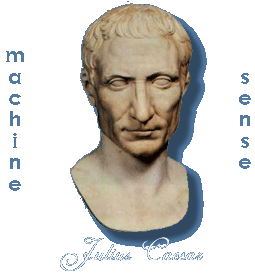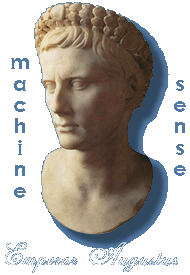| C r y p t o l o g y : C a e s a r C i p h e r |
As a rule, men worry more about what they can't see than about what they can. |
 |
A Caesar cipher is a simple shift cipher. It is a monoalphabetic substitution cipher. Julius Caesar used a shift of 3 for his correspondence, including battlefield messages. The Ancient History Sourcebook has an English translation of De Vita Caesarum: Julius by the Roman historian Suetonius, wherein Suetonius describes Julius Caesar's writings (war commentaries, memoirs, poetry and correspondence). His data footprint, as it were. According to Suetonius: There are also letters of his to Cicero, as well as to his intimates on private affairs, and in the latter, if he had anything confidential to say, he wrote it in cipher, that is, by so changing the order of the letters of the alphabet, that not a word could be made out. If anyone wishes to decipher these, and get at their meaning, he must substitute the fourth letter of the alphabet, namely D, for A, and so with the others. |
The first Roman emperor Augustus used this cipher with a shift of 1. As described by Suetonius:
He does not strictly comply with orthography, that is to say the theoretical rules of spelling laid down by the grammarians, seeming to be rather of the mind of those who believe that we should spell exactly as we pronounce. Of course his frequent transposition or omission of syllables as well as of letters are slips common to all mankind. I should not have noted this, did it not seem to me surprising that some have written that he cashiered a consular governor, as an uncultivated and ignorant fellow, because he observed that he had written izi for ipsi. Whenever he wrote in cipher, he wrote B for A, C for B, and the rest of the letters on the same principle, using AA for X. |
 |
| In a shift cipher, each letter of the alphabet is shifted a certain number of places further down the alphabet. The number of places shifted is the key. In the Caesar Cipher, the key is 3: A is replaced with D, B is replaced with E and so on. |
| Position | 1 | 2 | 3 | 4 | 5 | 6 | 7 | 8 | 9 | 10 | 11 | 12 | 13 | 14 | 15 | 16 | 17 | 18 | 19 | 20 | 21 | 22 | 23 | 24 | 25 | 26 |
| Alphabet | A | B | C | D | E | F | G | H | I | J | K | L | M | N | O | P | Q | R | S | T | U | V | W | X | Y | Z |
| Caesar | D | E | F | G | H | I | J | K | L | M | N | O | P | Q | R | S | T | U | V | W | X | Y | Z | A | B | C |
| Augustus | B | C | D | E | F | G | H | I | J | K | L | M | N | O | P | Q | R | S | T | U | V | W | X | Y | Z | A |
| ROT-13 | N | O | P | Q | R | S | T | U | V | W | X | Y | Z | A | B | C | D | E | F | G | H | I | J | K | L | M |
|
How secure is this encryption method? In the context of the early Roman empire: Fairly secure. Consider the low literacy rate in the general population during the lifetimes of Julius Caesar and Emperor Augustus. Cryptanalysis was an even more rarified ability. Caesar's encrypted messages were not easily accessible by the the general public, much less his enemies. To decode such a message, you had to be able to intercept the message and be literate and know that the gibberish message could be parsed with a little cryptanalysis. Opportunity and ability and awareness. How secure are Caesar's writings today? Opportunity: We have Caesar's writings. Some material has been lost to the ages, but previously protected information is now studied for its historical value, outweighing Caesar's need for personal privacy. Think declassified information. Think Anne Frank's diary. Sorry, Jules. Ability: The literacy rate is much higher now. Most gradeschoolers could (if so inclined) read the text. Awareness: Ah, there it is. You still need to know that a hidden message exists under all that gibberish. Still, the Caesar Cipher is less effective today as an encryption method than it was two millennia ago. With a simple code like the Caesar cipher, the work factor is very small. The number of possible shifts (i.e. keyspace) is limited to 26. This means that intercepted messages are easy to decrypt by brute force or frequency analysis. There are stories (possibly apocryphal) of how the Russians used a simple shift cipher during World War I because their soldiers were unable to comprehend more complex codes. German and Austrian cryptanalysts easily broke the Russian codes. But simplicity also equates to ease of use. This means that the intended recipients in Caesar's time (e.g. Roman troops) could have easily decrypted Caesar's messages, especially since they knew the key. Battlefield messages need to be protected from enemy eyes, but the intended recipient must also be able to decrypt them. Otherwise what we've got here is failure to communicate. This simple cipher is not suitable for long-term data encryption. Given enough time, all codes can be broken. It is just a question of how long the decryption process will take, and how useful the information is after an attacker has decrypted it. A key consideration in data encryption is to use a cryptosystem that will keep the message encrypted beyond the useful lifespan of the data. I'll bet Caesar never expected his War Commentaries to be freely available on the Internet. |
| Related Topics | |
| ROT-13 |
A symmetric shift cipher utilized on USENET. |
| External Links |
|
| De Vita Caesarum: Divus Iulius | The Lives of the Caesars, The Deified Julius by Suetonius at the Ancient History Sourcebook. |
| De Vita Caesarum: Divus Augustus | The Lives of the Caesars, The Deified Augustus by Suetonius at the Ancient History Sourcebook |